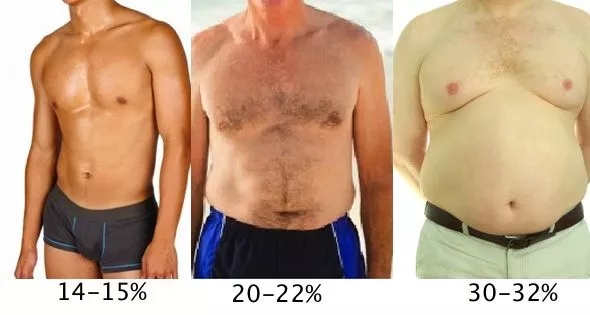給你們講個恐怖故事:
天氣熱起來了,
又到了一年一度露腿露腰的季節(jié),
而你的陳年老肥還沒減掉……
常言道,五月不努力,六月徒傷悲。肥可以減,但是你得弄明白一件事——你真的胖嗎?
雙語君(微信ID:Chinadaily_Mobile)下面教你4個簡單且科學的方式,判斷自己胖不胖。
(雙語君還得嘮叨一句,小可愛們不要拿明星做對照,畢竟不是每個人都要瘦成一道閃電才行,身體健康最重要。)
01、算體重指數(shù)(BMI)
最簡單的方式就是計算體重指數(shù)(BMI, body mass index):
Just input your height and weight into one of many Web calculators or charts, and you'll get back a number that pegs you as underweight, healthy, overweight, obese, or extremely obese.
把你的身高體重填入網(wǎng)上各種計算器或者表格對照計算,會得到一個數(shù),把你歸類于偏瘦、健康、偏胖、肥胖或極度肥胖等幾類。
或者自己用公式計算:BMI =體重(千克)/ 身高(米)的平方。

根據(jù)得到的數(shù)值,對照下面的表,就可以自行判斷啦。

不過,BMI并不適用于運動員。
People who are really muscular, like pro athletes, may have a BMI score in the "overweight" range when they actually have very little body fat.
真正的肌肉人士,比如運動員,按照BMI得分可能會被劃到“偏胖”的范圍,但其實他們身體脂肪很少。
而有些人雖然BMI正常,但是體脂可能太多,也是不健康的,容易引發(fā)各種疾病。
BMI might give a misleading impression to people who are normal weight but have a high percentage of body fat and therefore a higher risk of heart disease, diabetes, and hypertension.
對于體重正常,但體脂高的人來說,BMI可能會產(chǎn)生誤導,這種情況下心臟病、糖尿病及高血壓的患病風險更高。
02、量腰圍
第二種判斷辦法就是量腰圍(measuring waist circumference):
Thishinges on the idea that the fat that accumulates around the waistis what really matters in terms of disease risk.
使用這個辦法是因為,就疾病風險而言,腰部脂肪是真正重要的因素。
hinge on:取決于;依……而定
waist [we st]:腰部
找不到腰圍正確測量位置的同學們,雙語君(微信ID:Chinadaily_Mobile)偷偷告訴你,就繞著肚臍量就好了。
wrapping a measuring tape around the upper hipbone, which should run across your navel
把測量尺放在臀骨上部測量,繞肚臍一周
hipbone:髖骨
navel ['ne v( )l]:肚臍

那么腰圍多少算肥胖呢?
If you're a man with a waist larger than 40 inches or a woman with a waist larger than 35 inches, you need to lose some fat.
如果男士腰圍大于101厘米,女士腰圍大于88厘米,你就要減肥啦。
03、測腰臀比
另外的一個辦法就是測腰臀比(waist-to-hip ratio),具體操作如下:
To calculate it, measure your waist at its narrowest point and divide that number by your hip circumference, as measured at its widest point.
腰部最細部分的圍度除以臀部最粗部分的圍度,即可得到腰臀比。
divide by:用……除
circumference [s 'k mf r ns]:圓周;周長
A woman with a 29-inch waist and 37-inch hips, for example, would have a WHR of 0.78. The general guidelines are no higher than 0.85 for women and 0.9 for men.
如果某女生腰圍29英寸(約74厘米),臀圍(約94厘米),她的腰臀比即為0.78。就腰臀比而言,整體要求是,女性不超過0.85,男性不超過0.9。
04、測體脂率
有的人體重指數(shù)(BMI)可能在正常范圍內(nèi),但他仍然看著偏胖,原因是在他的體重中,脂肪占的比例多于肌肉。
所以,相對于BMI,體脂率才是更準確的衡量你是不是真胖的一個指標。
體脂率(body fat percentage),即脂肪含量在人總體重中所占的比例。
不同體脂率的人一般長什么樣,以下兩組圖清晰直觀,可做大致參考。
女生


男生


對于非運動員來說,女生的理想體脂率大約為18%-25%,男生則在10%-18%的范圍內(nèi)。
注意,體脂并不是越少越好,過低的體脂率會減慢新陳代謝,引發(fā)內(nèi)分泌失調(diào)等問題。
想知道自己的體脂有多少,以下告訴你幾個常用的測量方法:
目測(Take a Look)
對照上面的兩組圖,大致判斷一下自己屬于哪個區(qū)間,這種測量方法不是很精確。
體脂夾(Body Fat Calipers)
買一個體脂夾,很便宜的,然后自己測量。

Pull the fat away from your muscles, pinch them with the caliper, take the measurements, and look at a chart to figure out your body fat percentage.
拉起一坨肥肉,用體脂夾夾住,測量數(shù)據(jù),然后根據(jù)一些表格對應(yīng)算出你的體脂。
caliper:['k l p ] 卡尺;卡鉗
注意,每次最好測量同一部位的脂肪。
公式計算(The measurement method)
比較流行的一種測量公式是美國海軍設(shè)計的體脂測量公式(US Navy formula)。
This method calculates the amount of fat in your body by using various body measurements.
這種方法利用測量身體各部分圍度來計算體脂。
♀
女性體脂測量公式
Body Fat Formula For Women
A:總體重(lbs) x 0.732 + 8.987
B:腕圍(手腕最粗的位置,inch) / 3.140
C:腰圍(肚臍處,inch) x 0.157
D:臀圍(臀部最粗的位置,inch) x 0.249
E:前臂圍(肘關(guān)節(jié)前最粗的位置,inch) x 0.434
瘦體重(Lean Body Mass)= A+B-C-D+E
體脂(Body Fat Weight)= 總體重 - 瘦體重
體脂率(Body Fat Percentage)= (體脂 x 100) / 總體重
注:
體重單位為磅(lbs),1 kg=2.2 lbs
長度單位為英寸(inch),1 inch=2.54 cm
♂
男性體脂測量公式
Body Fat Formula For Men
A:總體重 x 1.082 + 94.42
B:腰圍 x 4.15
瘦體重= A - B
體脂 = 總體重 - 瘦體重
體脂率 = (體脂 x 100) / 總體重
注:
體重單位為磅(lbs),1 kg=2.2 lbs
長度單位為英寸(inch),1 inch=2.54 cm
BIA測法(Bioelectric Impedance Analysis)
BIA測法即生物電阻抗分析法,去過健身房的朋友大概都體驗過這種測量方法。
原理是這樣的:
BIA works on the principle that fat has a low water content and doesn’t conduct electrical currents very well. Muscle, on the other hand, contain more water and conducts electricity better.
BIA測法的原理是,脂肪含水少,基本不導電。而肌肉含水多,容易導電。
健身房常用的儀器就是用這種原理,通過測試電流在體內(nèi)循環(huán)的速度來預(yù)測體脂率。
越胖的人含水越少,測出的體脂率就越高。
這種方法相對精確,但也不一定完全靠譜,比如,如果你測之前喝了大量的水,得到的數(shù)值就不準啦。
好了,四種方法介紹完畢。
不吃難受、吃一口內(nèi)疚的寶寶們,快按照雙語君(微信ID:Chinadaily_Mobile)介紹的方法,測起來吧!
胖的趕緊減肥,瘦的控制好體重,畢竟胖和瘦只是一口之遙(別問我怎么知道的)……
下面,雙語君(微信ID:Chinadaily_Mobile)還整理了一些健康飲食攻略,供大家參考。
Consume a Variety of Foods
多種多樣地吃
Not all the nutrients and other substances in foods that contribute to good health have been identified, so eating a wide assortment of foods helps ensure that you get all of the disease-fighting potential that foods offer.
食物中不是所有對健康有益的營養(yǎng)物質(zhì)和其他物質(zhì)都已經(jīng)被檢測出來了,所以多種多樣地吃可以獲取食物中抗病潛能。
Get More Whole Grains
多吃全谷物
At least half your grains should be whole grains, such as whole wheat, barley and oats. Whole grains retain the bran and germ and thus all (or nearly all) of the nutrients and fiber of the grain.
你吃的谷物里,至少有一半應(yīng)該是全谷物,比如全麥、全大麥、全燕麥。全谷物保留了谷物中的糠和胚芽,因此也就保留了谷物中全部(幾乎全部)的營養(yǎng)物質(zhì)和纖維。
Limit Refined Grains, Added Sugar
控制精制谷物和添加糖
These are sources of empty calories that contribute to weight gain. Many sugary foods are also high in fat, so they’re even more calorie-dense.
(精制谷物和添加糖)是空卡(無營養(yǎng)卡路里)的來源,為長胖添磚加瓦。很多含糖類食物也是高脂肪的,所以這類食物熱量更高。
Enjoy More Fish and Nuts
多吃魚肉和堅果
Nuts, fatty fish, avocados and vegetable oils supply healthy unsaturated fats. Still, it’s best to eat them in place of other high-calorie foods.
堅果、多脂魚、牛油果和植物油提供健康的不飽和脂肪酸。當然,最好是用這些來替代高熱量食物。
Watch Your Calcium and Vitamin D
注意鈣和維生素D的攝入
These nutrients are vital for bone health.
鈣和維生素D對骨骼健康至關(guān)重要。
Be Aware of Liquid Calories
注意液體熱量
Some liquid calories come from healthy beverages, such as milk and 100 percent fruit juice. But most come from soda and other sweetened beverages and alcoholic drinks, which have lots of calories yet few, if any, nutrients.
一些液體熱量來自健康飲品,比如牛奶和純果汁。但是大部分都是來自碳酸飲料、其它甜味飲料及酒精飲品,這些飲品含有大量熱量,營養(yǎng)物質(zhì)則少之又少。
編輯:唐曉敏 左卓
(來源:中國日報雙語新聞編輯部)
